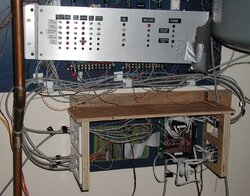I should begin this by admitting and being clear that I know my way around analog circuitry much better than digital
also, I am still at the stage of figuring out and getting ready to build the basic functional aspects of my system, and have been thinking of the control/ monitoring parts only as they relate to things I really ought to consider in the design of the basic piping/ pumping/ valving
that said, the point will come when I'll need to turn to planning controls, so have been trying to think some about that, too
I remembered a device that a friend of mine has played around with in connection with PIC processors, and that would seem to have potential superb adaptability for measurement and control for some of the complexities of wood boilers + storage- "Dallas Semiconductor DS18B20 One-Wire 12 bit temperature sensor"
data sheet--
http://wulfden.org/stamps/DS18B20.pdf
they actually appear to be cheaper than thermistor sensors, and the ability to have mulriple sensors on a one-wire-pair system, but to have a microprocessor be able to distinguish among each of them, looks really intriguing.
Some of you around here (nofossil & I am sure others) know a lot more than I do about digital interfaces, processors, etc- what do you folks think of the potential of this device? and for a "relative digital newbie" what might be a good set up to tie into and program to accept & process the inputs and then make decisions on what devices to actuate, and in what sequence? bear in mind that I am not a programmer, and not aiming to have to become one on any sophisticated level
thanks!
also, I am still at the stage of figuring out and getting ready to build the basic functional aspects of my system, and have been thinking of the control/ monitoring parts only as they relate to things I really ought to consider in the design of the basic piping/ pumping/ valving
that said, the point will come when I'll need to turn to planning controls, so have been trying to think some about that, too
I remembered a device that a friend of mine has played around with in connection with PIC processors, and that would seem to have potential superb adaptability for measurement and control for some of the complexities of wood boilers + storage- "Dallas Semiconductor DS18B20 One-Wire 12 bit temperature sensor"
data sheet--
http://wulfden.org/stamps/DS18B20.pdf
they actually appear to be cheaper than thermistor sensors, and the ability to have mulriple sensors on a one-wire-pair system, but to have a microprocessor be able to distinguish among each of them, looks really intriguing.
Some of you around here (nofossil & I am sure others) know a lot more than I do about digital interfaces, processors, etc- what do you folks think of the potential of this device? and for a "relative digital newbie" what might be a good set up to tie into and program to accept & process the inputs and then make decisions on what devices to actuate, and in what sequence? bear in mind that I am not a programmer, and not aiming to have to become one on any sophisticated level
thanks!


